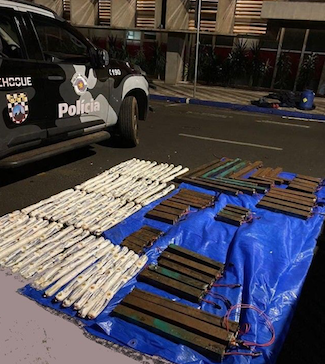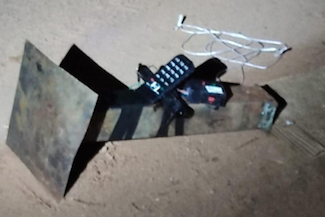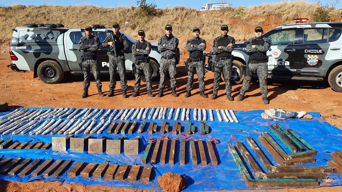Third Generation Gangs Strategic Note No. 42: Brazilian Gangs Utilize Human Shields, Explosives, and Drones in a New ‘Cangaço’ Style Urban Bank Raid in Araçatuba, São Paulo

Third Generation Gangs Strategic Note No. 42: Brazilian Gangs Utilize Human Shields, Explosives, and Drones in a New ‘Cangaço’ Style Urban Bank Raid in Araçatuba, São Paulo
John P. Sullivan, José de Arimatéia da Cruz, and Robert J. Bunker
On Sunday 29 August 2021, at approximately 2200 hours, around 20 armed gunmen conducted a series of raids on three banks in Araçatuba, São Paulo, killing at least three. The armed commando wore bulletproof vests and helmets and used assault rifles, explosives, and drones. Hostages were also used as human shields to hamper their capture and facilitate escape. Blockades constructed from burning vehicles, as well as explosives were deployed to facilitate their escape during the ‘mega-robbery.’ Brazil has been plagued by this type ‘urban bank raid’ in recent years.

Human Shields tied to roof and hood of vehicle fleeing Bank Robbery Source: Screen Shot from video by Yuri Macri @yurimacri. Twitter, 29 August 2021, https://twitter.com/yurimacri/status/1432210171711922182?s=20.
Key Information: “Brazil bank robbers tie hostages to getaway cars in Araçatuba.” BBC News. 30 August 2021, https://www.bbc.com/news/world-latin-america-58382410:
Bank robbers strapped hostages to the top of their getaway vehicles after a raid in the southern Brazilian city of Araçatuba.
Police said that at least three people were killed, among them one suspect.
Officials said more than 20 people took part in the heist, blocking off roads with burning vehicles and placing explosive devices across the city…
…News site G1 reports that the gang used drones to monitor the movements of the police from the air.
It is not the first time Araçatuba has been targeted by bank robbers. In 2017, criminals took control of various strategic spots throughout the city, attacked police stations and blocked roads as part of their robbery of a private security firm.
Key Information: “Assalto em Araçatuba: Gate localiza 98 explosivos espalhados por criminosos que atacaram bancos.” G1 (Globo), (Rio Preto e Araçatuba). 31 August 2021, https://g1.globo.com/sp/sao-jose-do-rio-preto-aracatuba/noticia/2021/08/31/assalto-em-aracatuba-gate-localiza-quase-100-explosivos-espalhados-por-criminosos-que-atacaram-bancos.ghtml:
Policiais do Grupo de Ações Táticas Especiais (Gate) localizaram 98 explosivos deixados pela quadrilha que atacou bancos em Araçatuba, nesta segunda-feira (30).
Os artefatos foram encontrados nas ruas, nos bancos, nos carros abandonados entre Gabriel Monteiro e Bilac, e também em um caminhão deixado pelo grupo perto das agências bancárias. Confira abaixo:
- 32 artefatos nas ruas
- 29 artefatos no caminhão abandonado
- 18 artefatos deixados no Banco do Brasil
- 19 artefatos achados em carros abandonados em Bilac
- 70 cartuchos de emulsão no caminhão[1]
Key Information: “‘Éo mesmo modus operandi’, diz delegado sobre assalto a banco em Criciúma e ação de quadrilha em Araçatuba.” G1 (Globo). 30 August 2021, https://g1.globo.com/sc/santa-catarina/noticia/2021/08/30/e-o-mesmo-modus-operandi-diz-delegado-sobre-assalto-a-banco-em-criciuma-e-acao-de-quadrilha-em-aracatuba.ghtml:
Cidades cercadas
Nas duas ações, os criminosos cercaram a região central das cidades. Em Criciúma, o grupo promoveu bloqueios e barreiras na tentativa de dificultar a chegada da polícia até o local.
Em Araçatuba, eles também fecharam algumas entradas da cidade com veículos em chamas para evitar que equipes chegassem ao local, segundo a polícia. Na cidade paulistana, um drone foi usado para monitorar a movimentação dos agentes.[2]
Key Information: Gabriel Stargardter, “Robbers in Brazil stage brazen bank raids, taking hostages; at least 3 dead.” Reuters. 31 August 2021, https://www.reuters.com/world/americas/robbers-brazil-stage-brazen-bank-raids-taking-hostages-least-3-dead-2021-08-30/:
More than 20 heavily armed men carried out the attack, using 10 cars, Alvaro Camilo, the executive secretary of Sao Paulo’s military police, said at a news conference. As the criminals made their getaway, they used locals as human shields, and burned cars, while leaving a trail of explosive booby traps across the city, the military police said in a statement.
The attackers used drones to monitor the streets as they entered the city, hit the banks, and made their getaway, the statement said.
Third Generation Gangs Analysis
The “Novo Cangaço” (“New Struggle”) refers to a type of brigandage or social banditry reminiscent of that form of criminality found in Brazil in the 1920s-1930s.[3] Typically, these attacks are characterized by brazen urban bank robberies. These incidents resemble light infantry assaults. In the recent ‘Mega-Robbery’ sequence, around 15-20 armed criminal commandos attacked three banks in the center of Araçatuba, western São Paulo. Hostages were taken and used as human shields to deny counter-fires, streets were blockaded to facilitate escape and evasion (E&E), and explosives were deployed to hinder interdiction. The offenders’ assault succeeded, resulting in the death of three persons.[4]
Other recent attacks are largely centered in São Paulo (SP), but have also occurred in Criciúma, Santa Catarina (2 December 2020) and Cametá, Pará (1 December 2020).[5] These were preceded by an April 2017 assault on an armored care warehouse in Ciudad del Este, Paraguay by gang members using assault rifles, grenades, explosives, and a .50 caliber rifle.[6] The Primeiro Comando da Capital (PCC) or First Capital Command were suspected in those prior sequences.

Explosives recovered by Grupo de Ações Táticas Especiais (GATE), Polícia Militar do Estado de São Paulo (PMESP) from the Araçatuba Mega-Robbery Sequence, 29 August 2021. Source: PMESP.
Indeed, just over a year ago, the PCC was suspected in a complex urban bank robbery scenario in Botucatu, SP. In that sequence, on 30 July 2020, “A group of about 40 armed and masked thugs attacked at least three bank branches in the city—one of which was destroyed by explosives—took residents hostage and, for more than three hours, exchanged fire with police officers, injuring two of them. One of the suspects was also shot and later died.”[7]

Proximity (and likely command detonated) Improvised Explosive Devices (IEDs) were used as obstacles on escape routes by the robbery crew on 29 August 2021. Recovered by the Polícia Militar do Estado de São Paulo (PMESP). Source: PMESP.
The Novo Cangaço has been described in the Brazilian press:
This criminal modality, which frightens the population because of the violence used, is called by police officers the “new cangaço”, in an allusion to the historical band of Lampião, who brought fear to cities in the northeastern hinterland in the mid-1930s…
…Generally, according to experts, suspects who contribute to gangs that attack banks are: arms dealers, corrupt police officers and employees of companies that pass or sell cargoes to criminals (learn more below).[8]
The classification Novo Cangaço refers to a type of criminal activity, specifically brigandage or activities by brigands following the style of classic Brazilian social bandits from the Northeast of Brazil. Lampiao and Maria Bonita were notorious “Cangaceiros.” The Cangaço started around colonial times in Brazil’s Northeast region (Bahia, Paraiba, Rio Grande do Norte) and ended in the 1930s at the hands of Getulio Vargas. The Novo Cangaço (New Cangaço), unlike the old Cangaço, are more organized, better armed, have international connections, and mostly rob Brazilian banks (Banco do Brazil, Itau, Caixa Econômica Federal).[9] Earlier this year, several cangaço raids were documented in four separate Brazilian states:
Between the 5th and 16th of April [2021], there were at least ten attacks in different cities in four states: São Paulo (SP), Paraná (PR), Bahia (BA) and Minas Gerais (MG). The targets were at least 13 bank branches and one financial [institution]. The gangs prefer to attack, for the most part, institutions that keep money in small towns, where the security forces do not have the military power to face heavily armed gangs.[10]
Explosives are a core element of the tactics, techniques, and procedures (TTPs) used in urban bank raids. As mentioned above, nearly 100 explosive artifacts were recovered in this recent bank assault sequence. A secondary TTP involves the taking of hostages during such incidents for the purposes of negotiation and use as human shields, however, this is the first instance in which they have been tied to getaway vehicles. The current fate of the ten hostages that were tied to the getaway vehicles is unclear. A tertiary bank heist TTP also appears to be the strewing bank notes along the getaway route, which results in civilians clogging the streets/choke points which impedes pursuing police and military forces. However, while this tactic was utilized during the Criciúma incident taking place in December 2020, it was not utilized in the present incident.[11] Another emergent TTP identified is the use of drones for ISR (intelligence, surveillance, and reconnaissance) purposes—as occurred in this incident.[12].

Explosive artifacts recovered by the Polícia Militar do Estado de São Paulo (PMESP) from the Araçatuba Mega-Robbery Sequence, 29 August 2021. Source: PMESP.
The complexity of this attack demanded synchronized response from São Paulo’s Military and Civil Police (Polícia Militar do Estado de São Paulo – PMESP and Polícia Civil do Estado de São Paulo – PCESP) and ultimately Brazil’s Federal Police.[11] This type of complex attack sequence is similar to the ‘urban siege’ tactics developed by terrorists. Indeed, many of the same issues of tactical and operational co-ordination are required to address the TTPs employed in Novo Cangaço scenarios.[12] This bank assault sequence, initiated by a heavily armed and highly coordinated criminal gangs, along with and similar incidents in recent years, suggest that these criminal armed groups (CAGs) are evolving in sophistication and now possess operational capability beyond those possessed by most municipal or state level law enforcement agencies.
Sources
Assalto em Araçatuba: Gate localiza 98 explosivos espalhados por criminosos que atacaram bancos.” G1 (Globo), (Rio Preto e Araçatuba). 31 August 2021, https://g1.globo.com/sp/sao-jose-do-rio-preto-aracatuba/noticia/2021/08/31/assalto-em-aracatuba-gate-localiza-quase-100-explosivos-espalhados-por-criminosos-que-atacaram-bancos.ghtml.
“Brazil bank robbers tie hostages to getaway cars in Araçatuba.” BBC News. 30 August 2021, https://www.bbc.com/news/world-latin-america-58382410.
Chris Dalby, “The Descent into Madness of Brazil’s Bank Robberies.” InSight Crime. 31 August 2021, https://insightcrime.org/news/the-descent-into-madness-of-brazils-bank-robberies/.
“‘Éo mesmo modus operandi’, diz delegado sobre assalto a banco em Criciúma e ação de quadrilha em Araçatuba.” G1 (Globo). 30 August 2021, https://g1.globo.com/sc/santa-catarina/noticia/2021/08/30/e-o-mesmo-modus-operandi-diz-delegado-sobre-assalto-a-banco-em-criciuma-e-acao-de-quadrilha-em-aracatuba.ghtml.
Gabriel Stargardter, “Robbers in Brazil stage brazen bank raids, taking hostages; at least 3 dead.” Reuters. 31 August 2021, https://www.reuters.com/world/americas/robbers-brazil-stage-brazen-bank-raids-taking-hostages-least-3-dead-2021-08-30/
Leber Tomaz, Caroline Borges, Fabio Rodrigues, and Carolina Andrade, “De onde vêm armas, munições e explosivos usados por quadrilhas do ‘novo cangaço’ em ataques recentes a bancos no Brasil?” G1 (Globo). 18 April 2021, https://g1.globo.com/sp/sao-paulo/noticia/2021/04/18/de-onde-vem-armas-municoes-e-explosivos-usados-por-quadrilhas-do-novo-cangaco-em-ataques-recentes-a-bancos-no-brasil.ghtml.
Endnotes
[1] In English, the title reads: “Assault in Araçatuba: Gate [Grupo de Ações Táticas Especiais] locates 98 explosives spread by criminals who attacked banks.” The text reads: “Police from the Special Tactical Actions Group (Gate) located 98 explosives left by the gang that attacked banks in Araçatuba, this Monday (30)…The [explosive] artifacts were found on the streets, on banks, in abandoned cars between Gabriel Monteiro and Bilac, and also in a truck left by the group near bank branches. Check it out below:
• 32 artifacts on the streets
• 29 artifacts in the abandoned truck
• 18 artifacts left at Banco do Brasil
• 19 artifacts found in abandoned cars in Bilac
• 70 emulsion cartridges in the truck.”
[2] The similarities in TTPs used in the 2 December 2020 raid in Criciúma were emphasized. In English, the title reads: “‘It’s the same modus operandi,’ says senior official about bank robbery in Criciúma and gang action in Araçatuba.” The text reads: “Fenced cities…In both actions, criminals surrounded the central region of cities. In Criciúma, the group promoted roadblocks and barriers in an attempt to make it difficult for the police to arrive at the location…In Araçatuba, they also closed some entrances to the city with burning vehicles to prevent teams from reaching the scene, police said. In the city of São Paulo, a drone was used to monitor the movement of agents.” Fenced cities evoke themes of ‘urban siege.’ See Note 14 below.
[3] See our earlier note, John P. Sullivan, José de Arimatéia da Cruz, and Robert J. Bunker, “Third Generation Gangs Strategic Note No. 33: Brazilian Gangs (Quadrilhas) Wage Urban Bank Raids in a New ‘Cangaço’.” Small Wars Journal. 2 February 2020, https://smallwarsjournal.com/jrnl/art/third-generation-gangs-strategic-note-no-33-brazilian-gangs-quadrilhas-wage-urban-bank.
[4] Chris Dalby, “The Descent into Madness of Brazil’s Bank Robberies.” InSight Crime. 31 August 2021, https://insightcrime.org/news/the-descent-into-madness-of-brazils-bank-robberies/.
[5] Op. cit, Sullivan, da Cruz, and Bunker, Note 3.
[6] John P. Sullivan and Robert J. Bunker, “Third Generation Gangs Strategic Note No. 4: Brigands, Bank Robbery, and Brazilian Gang Evolution at Ciudad del Este and the Triple Frontier.” Small Wars Journal. 26 May 2017, https://smallwarsjournal.com/jrnl/art/third-generation-gangs-strategic-note-no-4.
[7] In Portuguese, “Um grupo de cerca de 40 bandidos armados e mascarados atacou pelo menos três agências bancárias da cidade — uma delas foi destruída por explosivos —, fez moradores reféns e por mais de três horas trocou tiros com policiais, ferindo dois deles. Um dos suspeitos também foi atingido e morreu.” “A ameaça do ‘novo cangaço’, que causa terror no interior de SP.” BBC via G1 (Globo). 30 July 2020, https://g1.globo.com/sp/bauru-marilia/noticia/2020/07/31/a-ameaca-do-novo-cangaco-que-causa-terror-no-interior-de-sp.ghtml.
[8] In Portuguese, “Essa modalidade criminosa, que assusta a população pela violência empregada, é chamada por policiais de “novo cangaço”, numa alusão ao histórico bando de Lampião, que levava o medo a cidades do sertão nordestino em meados dos anos de 1930…Geralmente, segundo os especialistas, os suspeitos que contribuem com as quadrilhas que atacam bancos são: traficantes de armas, policiais corruptos e funcionários das empresas que passam ou vendem as cargas para os criminosos (saiba mais abaixo). Leber Tomaz, Caroline Borges, Fabio Rodrigues, and Carolina Andrade, “De onde vêm armas, munições e explosivos usados por quadrilhas do ‘novo cangaço’ em ataques recentes a bancos no Brasil?” G1 (Globo). 18 April 2021, https://g1.globo.com/sp/sao-paulo/noticia/2021/04/18/de-onde-vem-armas-municoes-e-explosivos-usados-por-quadrilhas-do-novo-cangaco-em-ataques-recentes-a-bancos-no-brasil.ghtml.
[9] See Luiz Bernardo Pericás, “Cangaço and Cangaceiros: Rural Banditry in the Brazilian Northeast.” Latin American History. 24 October 2018, https://doi.org/10.1093/acrefore/9780199366439.013.546.
[10] In Portuguese, “Entre os dias 5 a 16 de abril, foram pelo menos dez ataques em cidades diferentes de quatro estados: São Paulo (SP), Paraná (PR), Bahia (BA) e Minas Gerais (MG). Os alvos foram ao menos 13 agências bancárias e uma financeira. Os bandos preferem atacar, em sua maioria, instituições que guardam dinheiro em cidades pequenas, onde as forças de segurança não têm poderio bélico para enfrentar bandos fortemente armados.” Op. cit. Leber Tomaz, Caroline Borges, Fabio Rodrigues, and Carolina Andrade, Note 8.
[11] Rachael Bunyan, “Brazilian bank robbers leave cash strewn across the streets to aid their getaway as residents rush to pick it up after spectacular raids on four banks across city.” Daily Mail. 1 December 2020,https://www.dailymail.co.uk/news/article-9005423/Brazilian-bank-robbers-leave-cash-strewn-streets-aid-getaway.html.
[12] An unconfirmed precursor incident using a surveillance drone in the state of Ceará, Brazil may have taken place some years earlier. See Susan Friedberg, “Thieves Used Drone to Rob Bank.” Dedrone. 18 August 2015,https://blog.dedrone.com/en/thieves-used-drone-to-rob-bank.
[13] “A Polícia Federal, juntamente com as demais forças de Segurança Pública do estado de São Paulo, está atuando ativamente na investigação do roubo ocorrido nas agências bancárias da cidade de Araçatuba e na busca dos criminosos, aguardando a conclusão dos trabalhos do Grupo de Ações Táticas Especiais (GATE) na localização e desativação dos artefatos explosivos, a fim de que a normalidade seja restabelecida o mais breve possível à populaçãolocal.” [“The Federal Police, together with other Public Security forces in the state of São Paulo, are actively investigating the theft that occurred at bank branches in the city of Araçatuba and in the search for criminals, awaiting the conclusion of the work of the Special Tactical Actions Group (GATE) in the location and deactivation of explosive devices, so that normality is restored as soon as possible to the local population.” “Roubo a agências bancárias em Araçatuba/SP.” Nota à Imprensa. 30 August 2021 (2250 hours). Polícia Federal, Setor de Comunicação Social da Superintendência da PF em São Paulo, https://www.gov.br/pf/pt-br/assuntos/noticias/2021/08/nota-a-imprensa-3.
[14] See John P. Sullivan, “Policing Urban Conflict: Urban Siege, Terrorism and Insecurity.” Stratfor. 10 April 2018, https://marcom.stratfor.com/horizons/fellows/dr-john-p-sullivan/30042018-policing-urban-conflict-urban-siege-terrorism-and-insecurity.
For Additional Reading
Chris Dalby, “The Descent into Madness of Brazil’s Bank Robberies.” InSight Crime. 31 August 2021.
John P. Sullivan and Robert J. Bunker, Eds., Strategic Notes on Third Generation Gangs. Bloomington, IN: Xlibris, 2020.
John P. Sullivan, José de Arimatéia da Cruz, and Robert J. Bunker, “Third Generation Gangs Strategic Note No. 33: Brazilian Gangs (Quadrilhas) Wage Urban Bank Raids in a New ‘Cangaço’.” Small Wars Journal. 2 February 2020.
John P. Sullivan and Robert J. Bunker, “Third Generation Gangs Strategic Note No. 4: Brigands, Bank Robbery, and Brazilian Gang Evolution at Ciudad del Este and the Triple Frontier.” Small Wars Journal. 26 May 2017.
Carlos Frederico de Oliveira Pereira, Gangues Territorias e Direito International dos Conflitos Armadas. Curitiba: Juruá Editora, 2016.




